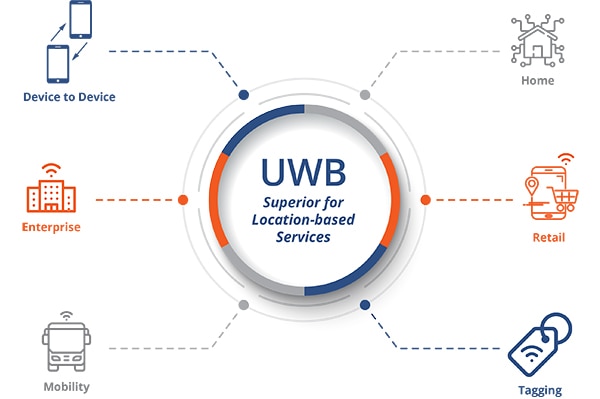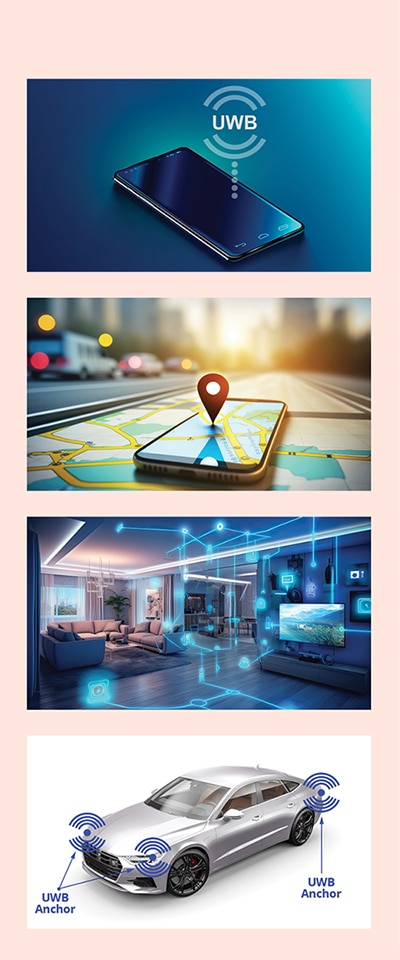频率控制如何确保 UWB 应用可靠、安全
2024-07-17
超宽带 (UWB) 是在第二次世界大战期间为安全通信和雷达系统开发的,后来被禁止用于商业用途,几十年来一直未得到充分利用。2002 年发布的美国联邦法规允许广泛地使用 UWB。此后,该技术在工业、消费、通信和汽车等越来越多的商业应用中获得了显著的发展。这些应用都利用了该技术的精确定位和位置跟踪能力,以及这种无线协议所带来的高速数据传输和最小功耗。
与蓝牙和 Wi-Fi 等其他短程无线通信协议一样,可通过 UWB 创建个人局域网 (PAN),实现电子设备互连并促进个人周围的数据传输。PAN 不通过 LAN 或 WAN 发送数据,而是在个人附近的设备之间传输信息。
然而,UWB 在几个关键方面与其他传输技术不同,这也推动了 UWB 在越来越多的主流无线应用中得到使用。
 图 1:UWB 的安全、宽频率范围和精确检测功能使许多主流无线应用成为可能。(图片来源:Aker Technology)
图 1:UWB 的安全、宽频率范围和精确检测功能使许多主流无线应用成为可能。(图片来源:Aker Technology)
UWB 的工作频率非常高,且不会干扰其他无线协议。该技术有助于实现空间音频、智能家居集成和非接触支付系统等特性,在汽车、移动和消费设备(如智能手机和标签设备)中尤其有用。这项技术有助于实现安全免提访问、室内导航、非接触支付、凭证共享和物品追踪等高级功能。
UWB 带来的优势
虽然蓝牙和 Wi-Fi 都已在无线通信领域占有一席之地,但由于 UWB 速度更快、更安全且精度极高,将在 10 - 20 m 范围的应用中占据主导地位。这主要得益于飞行时间 (ToF) 测量。
|
表 1:UWB 具有 3.1 ~ 10.6 GHz 频段,使得只有 2.4 ~ 5 GHz 频段的 Wi-Fi 和蓝牙的 相形见绌。由于工作频率范围更高,带宽更大,UWB 可以更安全地传输更多数据,是高速、短距离数据传输的理想选择。(图片来源:Aker Technology)
通过精确测量信号在设备间传输所需的时间,UWB 的 ToF 功能使外部攻击者更难访问或操纵 UWB 通信,这得益于其加密特性、随机数生成和其他安全技术。
除了安全性高之外,UWB 技术还具有功耗低、抗噪能力强、精确定位和位置跟踪以及信号易于穿透各种材料等优点。UWB 可以传输大量信号能量,而不会干扰同一频段内的传统窄带和载波传输。
无线速度(实时数据、精确定时):虽然 Wi-Fi 的数据传输速率比 UWB 稍高,分别为 600 Mbps 和 460 Mbps,但 UWB 类似雷达的探测能力使其成为无线应用的有效选择。(蓝牙的数据传输速率为 24 Mbps,仅供参考)。此外,UWB 的标称距离小于蓝牙或 Wi-Fi,最适合需要精确定时和实时数据传输的短距离应用。
准确性(定位、位置跟踪):UWB 在短距离内的准确性是其他无线技术无法比拟的,可确保更精确的设备定位。由于不受其他无线电传输和无线电猝发技术的干扰,UWB 可以有效地测量距离,精确度可达 10 cm 至 30 cm,远远优于 Wi-Fi(2 m 至 3 m)和蓝牙(1 m 至 5 m)的测量范围。
安全性(数据完整性、安全传输):UWB 的脉冲传输技术具有抗噪声和抗反射的特性,因此在各种应用中都具有很高的安全性。两个设备之间可直接连接以及精确测量特性,使 UWB 能够实时连接并验证设备的合法性,而不会出现无线电波被记录或转发。
功率效率(低漏电、最佳消耗):UWB 传输速度快,定时帧定义明确,因此比大多数短程协议更节能。该技术支持多种低功耗模式,包括休眠模式,可进一步优化功耗。对于小型电池供电设备(如 UWB 环境中的设备)来说,功耗是关键因素。
晶体振荡器可实现 UWB 应用
UWB 满足了短距离无线应用在宽频率范围内的许多要求,但这也提出了对精确频率控制的需求,以确保精确的定位、位置跟踪和高速数据传输,这正是 UWB 的优势所在。
|
表 2:满足 UWB 频率控制需求的典型高性能晶体。石英晶体是一种常用的频率控制器件,用于确保以正确的时间、速度传输信息时所需的信号和定时控制。晶体的稳定性、相位噪声特性和功率效率会影响 UWB 通信和定位系统的质量和可靠性。(图片来源:Aker Technology)
稳定的振荡器可提供可靠、准确的时钟信号,确保 UWB 脉冲保持所需的形状和频谱。换句话说,UWB 发射器产生的脉冲形状会受到振荡器提供的定时影响。
振荡器的频率漂移或不稳定会导致信号失真和性能低下,因此选择具有正确频率范围、容差和稳定性的晶体至关重要。其他关键参数包括封装类型、工作温度和负载电容。
主要 UWB 市场
UWB 首次出现在 iPhone 11 中,并迅速在大量基于 PAN 的应用中得以普及,其中包括了智能标签和车载参考点或锚点。UWB 技术有助于推动智能无线技术创新,更好地实现全球自动化。以下是 UWB 正在为各种短距离无线市场带来变革的其他几种方式(图 2):
工业 - UWB 用于资产跟踪、室内定位、监控系统、无线传感器网络和智能电网应用。该技术可为人员和设备提供准确的定位信息。
消费通信 -该技术用于智能手机、可穿戴设备、物联网、智能家居系统和智能标签,在短距离设备之间实现快速可靠的无线连接。UWB 可提供更准确的空间跟踪,如精确的室内定位。
汽车 -在汽车行业中,无钥匙进入、安全车辆访问、高级驾驶辅助系统 (ADAS) 和跟踪都通过 UWB 实现精确定位。
 图 2:UWB 应用。(图片来源:Aker Technology)
图 2:UWB 应用。(图片来源:Aker Technology)
频率控制助力无线创新
随着无线连接需求的日益扩大,特别是物联网设备的激增和 5G 网络的部署,正在将跨频段数据传输推向新的极限。不断发展的无线基础设施依赖 UWB 所提供的关键性能参数。
UWB 的工作频率范围广,可传输大量信号能量,而不会干扰同一频段的传统窄带和载波传输。如此宽的带宽分配需要准确的频率控制,以避免干扰在同一频段内工作的其他无线系统,并同步数据传输,保持可靠的通信。
结束语
UWB 技术实现了安全测距和精确检测,为无线设备创造了新的空间环境。UWB 可以传输大量信号能量,而不会干扰同一频段的传统窄带和载波传输。在物联网、可穿戴设备、实时定位、智能汽车门禁、家庭控制面板、点对点通信、自动解锁和门禁管理等领域,UWB 是未来的发展趋势;Aker 将通过其种类繁多的定时晶体参与其中。
免责声明:各个作者和/或论坛参与者在本网站发表的观点、看法和意见不代表 DigiKey 的观点、看法和意见,也不代表 DigiKey 官方政策。






